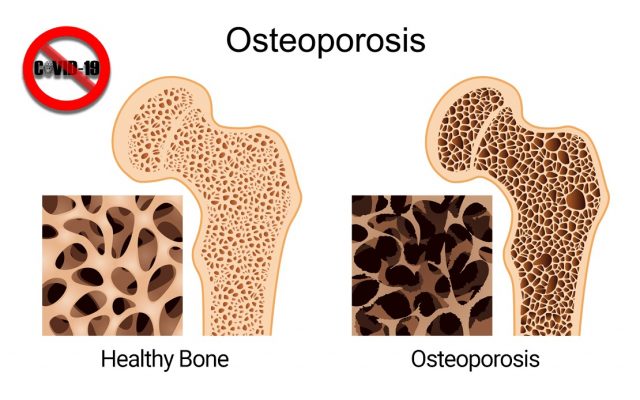WOMEN, CHILDREN FACE HIGH RISK OF DEVELOPING OSTEOPOROSIS

This article is in conjunction with World Osteoporosis Day which is observed annually on Oct 20.
KUALA LUMPUR (Bernama) – Although osteoporosis is often associated with senior citizens, it is women and even children who are at high risk of developing this bone disease.
Osteoporosis causes loss of bone density, as a result of which the bones become weak and brittle, thus increasing the risk of fractures.
According to MSU Medical Centre orthopaedic consultant Dr Ruzaimi Md Yusoff, in Malaysia not much attention is paid to osteoporosis and that there are still many people out there who are not aware they have this disease.
“Most of them seek treatment only after they have a fracture (one of the complications of osteoporosis). Awareness of this disease and its complications is still at a low level among the public.
“Due to this, there is no complete data on the prevalence of osteoporosis in Malaysia,” he told Bernama, adding that it is estimated that 77 percent of Malaysian women who have reached menopause have osteoporosis but do not seek treatment.
Not surprisingly, osteoporosis is often called a silent disease due to the absence of symptoms until, perhaps, a bone is broken. Some people with osteoporosis, however, may experience pain in their back or hips.
Dr Ruzaimi said decreasing estrogen levels in women after menopause is one of the factors that cause the bone density to decline rapidly.
Other factors include their sedentary lifestyle and smaller physique as compared to men, as well as their tendency to follow restricted diets.
“Many women don’t participate in outdoor activities which reduce their exposure to sunlight and vitamin D. This can reduce the body’s absorption of calcium (to build and maintain strong bones),” he said.
Globally, one in three women and one in five men above the age of 50 experience fractures due to bone fragility brought about by osteoporosis. Studies have also shown that osteoporosis causes 8.9 million people worldwide to experience fractures every year.
OSTEOPOROSIS IN CHILDREN
“Among the conditions that can cause osteoporosis in children are chronic inflammation due to juvenile idiopathic arthritis or Crohn’s disease, as well as anorexia nervosa which is an eating disorder,” he said.
Other causes of osteoporosis in children are long-term treatments involving steroid medications; osteogenesis imperfecta, a genetic bone disorder that affects the body’s ability to produce collagen which is an important element to keep bones strong; and cerebral palsy, a group of disorders that affect a person’s ability to move and maintain balance and posture.

YOUNG PEOPLE’S DISEASE
Nutritionist and dietitian at the Centre for Transformative Nutrition and Health at International Medical University Prof Winnie Chee Siew Swee, meanwhile, described osteoporosis as a “young people’s disease” with its effects only being visible as they grow older.
She said in view of this, it is important for children to keep themselves active in order to build muscle and lean body mass as these contribute to greater bone mineral density in the whole body and lumbar spine.
“Lean mass exerts a higher tensile force on bones and this stimulates the bone cells,” she explained.
Sharing the findings of a study she had carried out with a team of researchers in 2017, titled “Factors Associated with Bone Health Status of Malaysian Preadolescent Children in the PREBONE-kids Study”, to determine the bone health status of 243 children aged between nine and 11, Chee said nearly 33 percent of the respondents were found to be either overweight or obese.
“In other studies carried out in India and Iran, as well as among Caucasian children, it was found that respondents with healthy lean body mass had better bone density,” she said.
She said Malaysia should pay more attention to this matter because according to a United Nations Children’s Fund (UNICEF) survey, 12.7 percent of Malaysian children aged between five and 19 were obese, the second-highest in the ASEAN region.
“Leading an active lifestyle by participating in sports and other physical activities will certainly contribute to children’s bone health.
“During childhood, a child’s body and bones experience rapid growth and development, so this is the best time to build bone mass to prevent osteoporosis from setting in later,” she said, adding that studies have shown that a 10 percent increase in bone mass levels at a young age can reduce the risk of fractures caused by osteoporosis.
CALCIUM AND VITAMIN D
Chee said their 2017 study also found low calcium intake in children – the mean calcium intake for all respondents met only about 25 percent of the nationally recommended calcium intake which is 1,300 mg to attain adequate growth rate and bone health.
She said low calcium intake in children would affect their bone density levels and also impact their growth and height.
Among the foods rich in calcium are skimmed milk, low-fat cheese, yogurt, anchovy or ikan bilis, tinned sardine, cooked dal, tofu, tempeh, watercress, kalian and sawi.
“Calcium intake should go with adequate vitamin D intake as the latter facilitates the absorption of calcium, which plays an important role in calcium homeostasis and skeletal bone development,” she said, adding that about 40 percent of the children who participated in the 2017 study had inadequate vitamin D levels, with the levels being much lower in the girls than boys.
This was because the girls who took part in the study were not as physically active as the boys and hence, did not get much exposure to sunlight.
MEASURE BONE HEALTH LEVEL
Meanwhile, explaining the development of osteoporosis, Dr Ruzaimi said it occurs when bone loss is faster than new bone formation.
Under normal circumstances, the bone resorption (removal of hard bone tissue) and bone formation processes take place at the same rate.
“Osteoporosis can affect all the bones in the body but usually it only involves the hip joints, wrists and spine,” he said, adding that the extent of the condition can be determined through the dual-energy X-ray absorptiometry test to measure the bone mineral density (BMD).
“According to the World Health Organisation, the normal BMD value for a young adult should exceed one SD (standard deviation) or a T-score >1SD. A person is categorised as having osteopenia or low bone density if their BMD value is between T-score ≤-1.0SD and >-2.5SD. Those with osteoporosis will have a BMD value of T-score ≤-2.5SD,” he explained.
Dr Ruzaimi also said that osteoporosis was treatable and that early treatment can help to prevent more serious complications from arising.
The treatments include estrogen replacement therapy or non-hormonal therapies such as the use of bisphosphonate, alendronate and risedronate.
He said the intake of milk or other dairy products can also increase calcium levels in the body.
“Those aged between 18 and 50 need 1,000 mg of calcium a day. Women over 50 and men over 70 need 1,200 mg of calcium a day,” he said, adding that to prevent osteoporosis, adequate calcium intake is essential starting from young to keep the bone density high and at an optimal level.
“After reaching adulthood, it’s important to retain bone density by taking adequate amounts of calcium and vitamin D, doing high-impact exercises, and abstaining from smoking and consuming alcoholic drinks.”
BERNAMA


